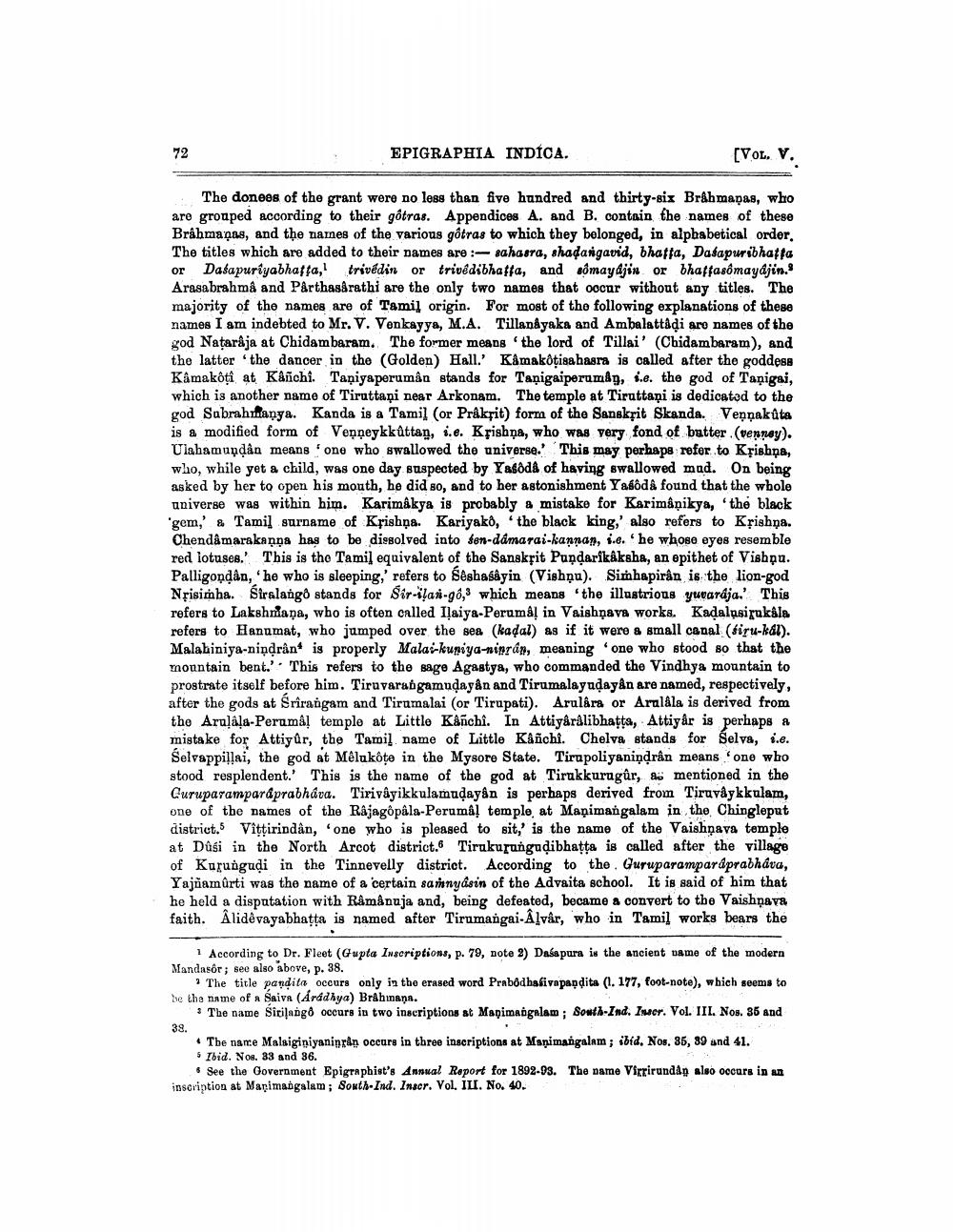________________
72
EPIGRAPHIA INDICA.
[VOL. V.
The donees of the grant were no less than five hundred and thirty-six Brahmapas, who are grouped according to their gôtras. Appendices A. and B. contain the names of these Brahmanns, and the names of the various gôtras to which they belonged, in alphabetical order, The titles which are added to their names are :- sahasra, shadangavid, bhatta, Dasapuribhatta or Dasapuriyabhafta, trivedin or trivedibhafta, and aômaydjin or bhaffasômaydjin. Arasabrahma and Parthasarathi are the only two names that cocor without any titles. The majority of the names are of Tamil origin. For most of the following explanations of these names I am indebted to Mr. V. Venkayya, M.A. Tillankyaka and Ambalattiļi aro names of the god Nataraja at Chidambaram. The former means the lord of Tillai' (Chidambaram), and the latter the dancer in the (Golden) Hall.' Kamakotisa hasra is called after the goddess Kamakoti at Kanchi. Taņiya perumân stands for Tanigaiperamag, s.e. the god of Tanigai, which is another name of Tirattaņi near Arkonam. The temple at Tiruttaņi is dedicated to the god Sabrahmanya. Kanda is a Tamil (or Pråkrit) form of the Sanskrit Skanda. Vennakuta is a modified form of Venneykküttan, s.e. Krishna, who was very fond of batter (venney). Ulahamuşdan means 'one who swallowed the universe. This may perhaps refer to Krishna, who, while yet a child, was one day suspected by Yafôdå of having swallowed mad. On being asked by her to open his mouth, he did so, and to her astonishment Yasod& found that the whole universe was within him. Karimákya is probably a mistake for Karimâņikya, 'the black 'gem, & Tamil surname of Krishna. Kariyako, the black king,' also refers to Krishna. Chendamarakanna has to be dissolved into sen-damarai-kannan, s.e. he whose eyes resemble red lotuses.' This is the Tamil equivalent of the Sanskrit Pundarikáksha, an epithet of Vishņu. Palligondân, he who is sleeping,' refers to Seshasayin (Vishņu). Simhapirân is the lion-god Nộisimha. Sirslangô stands for Sir-las-gô, which means the illustrious yuvarája.' This refers to Lakshniana, who is often called Ilaiya-Perumal in Vaishnava works. Kadalasigakala refers to Hanumat, who jumped over the sea (kadal) as if it were & small canal (firu-kal). Malahiniya-niņdrân" is properly Malai-kuniya-ninran, meaning one who stood so that the mountain bent.'. This refers to the sage Agastya, who commanded the Vindhya mountain to prostrate itself before him. Tiruvarangamudayån and Tirumalayadayan are named, respectively, after the gods at Srirangam and Tirumalai (or Tirupati). Arulara or Arulála is derived from the Aralala-Perumal temple at Little Kanchi. In Attiyårålibhatta, Attiyar is perhaps a mistake for Attiyür, the Tamil name of Little Kanchi. Chelva stands for Selva, s.e. Selvappillai, the god at Melukôte in the Mysore State. Tirupoliyanindrån means 'one who stood resplendent. This is the name of the god at Tirukkuragûr, to mentioned in the Guruparamparaprabhára. Tirivayikkulamudayan is perhaps derived from Tiruvâykkulam, one of the names of the Rajagopala-Perumal temple at Manimangalam in the Chinglepat district. Vittirindan, one who is pleased to sit,' is the name of the Vaishnava temple at Důsi in the North Arcot district. Tirukuzunguļibhatta is called after the village of Kurunguļi in the Tinnevelly district. According to the . Guruparampardprabháva, Yajñamurti was the name of a certain sannyúsin of the Advaita school. It is said of him that he held a disputation with Ramanuja and, being defeated, became a convert to the Vaishnava faith. Ålidêvayabhatta is named after Tirumangai-Alvar, who in Tamil works bears the
1 According to Dr. Fleet (Gupta Inscriptions, p. 79, note 2) Dasapura is the ancient name of the modern Mandasôr; see also above, p. 38.
The title pandito occurs only in the erased word Prabodhalivapaodita (1.177, foot-note), which seems to be the name of a Saiva (Aradhya) Bråhinana.
The name Sitilang occurs in two inscriptions at Manimangalam ; Sowth-Ind. Iwer. Vol. III. Nos. 35 and 38.
The name Malsiginiyaninrån occurs in three inscriptions at Manimangalam; ibid. Nos, 85, 89 and 41. 5 Ibid. Nos. 33 and 36.
See the Government Epigraphist's Annual Report for 1892-93. The name Virrinundan also occurs in an inscription at Marimangalam; South-Ind. Inger. Vol. ILI. No. 40.




